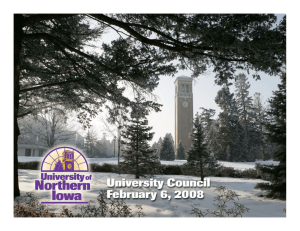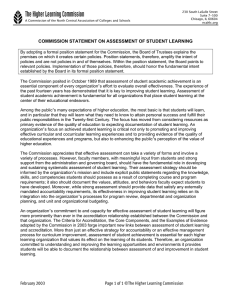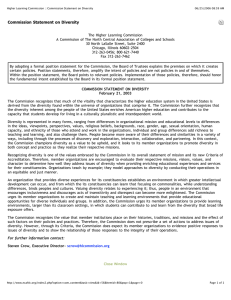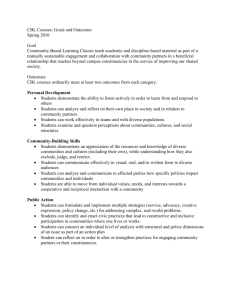Greetings to the Ohio Association of Institutional Research and Planning from
advertisement
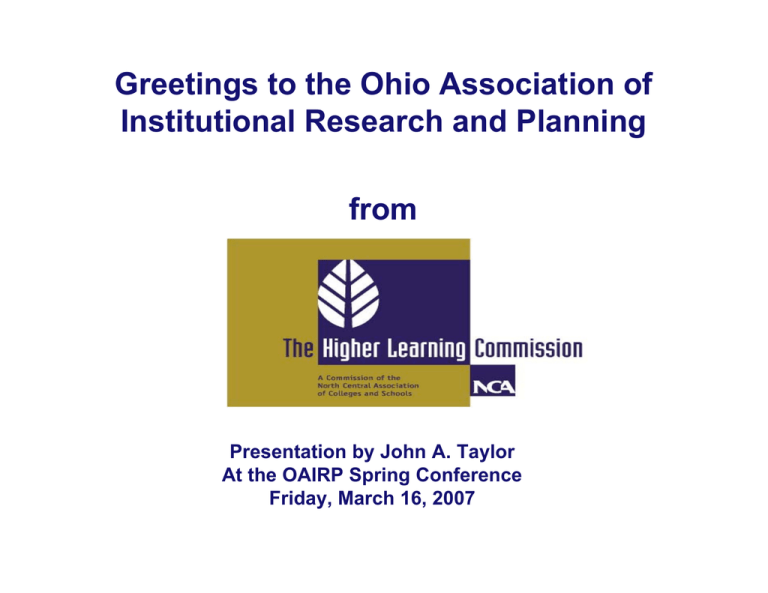
Greetings to the Ohio Association of Institutional Research and Planning from Presentation by John A. Taylor At the OAIRP Spring Conference Friday, March 16, 2007 Evidence Building for Accreditation Purposes Documenting Progress During Accreditation Providing Evidence as Proof of Student Learning And Institutional Effectiveness What, Who,Why, and How Are We? Institutional Diversity in Ohio’s Higher Education System Highest Degree Number Control and Type Doctor’s 25 12 - Public 13 - Private, NFP First Professional 9 1 - Public 8 - Private, NFP Master’s 36 2 - Public 34 - Private, NFP Bachelor’s 13 2 - Public 11 - Private, NFP Associate’s 27 24 - Public 3 - Private, NFP Defining an Organization Stated Purposes Vision Values Strategic Goals Objectives Anticipated Outcomes What is my institution’s Mission? Purpose--Vision--Values--Goals--Objectives--Outcomes The Public’s Perception of an Institution and Its Mission • What a higher learning institution says it is, and the outcomes it claims it produces. • Clear articulation of whom the targeted constituencies are, and the services, opportunities, and systems provided to support learning. • Transparency: Information that enables the public to see and understand what the institution actually provides and produces, at what cost and investment. Defining Evidence • That which tends to prove or disprove something • Data submitted to substantiate claims or reconcile competing claims • Something that gives a sign of existence or truth of something • Something that helps somebody to come to a particular conclusion Who are my institution’s Constituencies? Service Area--State--Regional--National--International Collaborators/Partners Evidence for Accreditation Organizationally - Documentation that an institution is fulfilling its mission serves as evidence that can be used to justify its reason for being, and prove its value to its constituencies. Globally - Documentation that the institution is meeting the Commission’s “Criteria and Core Components” [standards] provides evidence of its credibility within the higher education community, and its eligibility to receive external funding (governmental, private, etc.) The Higher Learning Commission Region 19 States 1003± Institutions Topical Areas of the Commission’s “Criteria for Accreditation” • • • • • Mission and Integrity Preparing for the Future Student Learning and Effective Teaching Acquisition, Discovery, and Application of Knowledge Engagement and Service “Handbook of Accreditation” - Chapter 3 www.ncahlc.org Academic Quality Improvement Program 1. 2. 3. 4. 5. Helping Students learn Accomplishing Other Distinctive Objectives Understanding Students’ and Other Stakeholders’ Needs Valuing People Leading and Communicating 6. 7. 8. 9. Supporting Institutional Operations Measuring Effectiveness Planning Continuous Improvement Building Collaborative Relationships Criterion Structure Criterion Statement Core Components Examples of Evidence Fundamental Shifts Inputs Outcomes Teaching Learning Outcomes Focus on Past Focus on Future Autonomy Connectedness 1 - Mission & Integrity The organization operates with integrity to ensure the fulfillment of its mission through structures and processes that involve the board, administration, faculty, staff, and students. 1 - Mission and Integrity [Core Components - Paraphrased] 1. Clear Articulation of the Mission 2. Recognition of Diversity among Learners, other Constituencies and the Greater Society 3. Organizational Understanding of Mission 4. Mission Supported through Organizational Structures 5. Organizational Protection of the Mission Examples of Evidence 2 - Preparing for the Future The organization’s allocation of resources and its processes for evaluation and planning demonstrate its capacity to fulfill its mission, improve the quality of its education, and respond to future challenges and opportunities. 2 - Preparing for the Future [Core Components - Paraphrased] 1. Realistic Preparation for a Future Shaped by Societal and Economic Trends 2. Resource Support for Maintaining and Strengthening Educational Programs 3. Evaluation and Assessment Processes Show Effectiveness and Continuous Improvement 4. Planning Levels Align with Mission and Capacity to Fulfill the Mission Examples of Evidence 3 - Student Learning and Effective Teaching The organization provides evidence of student learning and teaching effectiveness that demonstrates it is fulfilling its educational mission. 3 - Student Learning and Effective Teaching [Core Components - Paraphrased] 1. Clear Statements of Student Learning Outcomes That Make Effective Assessment Possible 2. Organization Values and Supports Effective Teaching 3. Organization Creates Effective Learning Environments 4. Learning Resources Support Student Learning And Effective Teaching Examples of Evidence 4 - Acquisition, Discovery, & Application of Knowledge The organization promotes a life of learning for its faculty, administration, staff, and students by fostering and supporting inquiry, creativity, practice, and social responsibility in ways consistent with its mission. 4 - Acquisition, Discovery, and Application of Knowledge [Paraphrased] 1. 2. 3. 4. Organization Demonstrates It Values a Life of Learning Organization Demonstrates the Integral Nature of Knowledge and Skill Acquisition, and Intellectual Inquiry Organization Assesses the Usefulness of Curricula to Students Living and Working in a Global, Diverse, and Technological Society Organization Supports Responsible Acquisition, Discovery, and Application of Knowledge Examples of Evidence 5 - Engagement and Service As called for by its mission, the organization identifies its constituencies and serves them in ways both value. 5 - Engagement and Service [Core Components - Paraphrased] 1. Organization Learns from Constituencies and Analyzes its Capacity to Serve Them 2. Organizational Capacity and Commitment to Engage with Identified Constituencies and Communities 3. Organization Demonstrates Responsiveness to Constituencies that Depend on It 4. Internal and External Constituencies Value the Organization’s Services Examples of Evidence 1 - The Role of Student Learning in Accreditation The institution defines educational quality --one of its core purposes--by how well it fulfills its declared mission on student learning. Clear about intended learning outcomes Uses learning goals and knowledge in organizing instruction Provides an environment that supports student learning Promotes an atmosphere of critical reflection about teaching and learning [Assessment] C-RAC - Wergin 2 - Documentation of Student Learning The institution demonstrates that student learning is appropriate for the certificate or degree awarded and is consistent with the institution’s own standards of academic excellence. Setting learning goals that speak to content and the expected level of attainment Collecting evidence of goal attainment,using appropriate assessment tools Applying collective judgment about the meaning and utility of the evidence Using the evidence to effect improvements C-RAC - Wergin 3 - Compilation of Evidence The institution derives evidence of student learning from multiple sources, such as courses, curricula, and co-curricula programming, and includes effects of both intentional and unintentional learning experiences. Use of periodic and longitudinal measures throughout the curriculum Exit or graduation/completion Post-graduation/completion activity C-RAC - Wergin 4 - Stakeholder Involvement The collection, interpretation, and use of student learning evidence is a collective endeavor, and is not viewed as the sole responsibility of a single office or person. Stakeholder Engagement: Those affected by decision-making--faculty, staff, students, parents, administration, board, etc. Gathering Information: Surveys, focused conversations Interpretation of the Data C-RAC - Wergin 5 - Capacity Building The institution uses broad participation in reflecting about student learning outcomes as a means of building a commitment to educational improvement. Leadership of engagement, and a culture of peer collaboration and review Flexible and decentralized evaluation policies, and a willingness to make and question assumptions Recognition of and valuing existing and new information, and reflecting on the information for purposes of decision-making and continuous improvement C-RAC - Wergin Assessment Conversations: “Five Prompt Questions” 1. 2. 3. 4. 5. How are your stated student learning outcomes appropriate to your mission, programs and degrees? What evidence do you have that students achieve your stated learning outcomes? In what ways do you analyze and use evidence of student learning? How do you ensure shared responsibility for assessment of student learning? How do you evaluate and improve the effectiveness of your efforts to assess and improve student learning? FOCUSING ON STUDENTS AND OTHER LEARNERS ACADEMIC AFFAIRS STUDENT AFFAIRS STUDENTS LEARNERS ADMINISTRATIVE & SUPPORT SERVICES LEARNING RESOURCES Gathering Evidence Formative Data & Information Summative Data & Information Anecdotal Data & Information Opinions Trend Data Statistical Analysis Weighing Evidence Determine if the evidence gathered is appropriate and sufficient Consider both longitudinal and normative evidence Longitudinal - Looking at Trend Data Normative - Comparing with a Benchmark Consider the level of detail necessary to support a judgment What is driving the call for greater accountability and transparency in higher education? Loud Voices/Big Ideas A Test of Leadership: Charting the Future of U.S. Higher Education-- Commission on the Future of Higher Education, Charles Miller Margaret Spellings Accreditation and Accountability: A CHEA Special Report--Judith Eaton Loud Voices/Big Ideas Rising Above the Gathering Storm: Energizing and Employing America for a Brighter Economic Future--Committee on Science, Engineering, and Public Policy Touch Choices,Tough Times--National Center on Education and the Economy, New Commission on the Skills of the American Workforce Toward a Public Universities and Colleges Voluntary System of Accountability for Undergraduate Education--NASULGC Summary of Recommendations from the Spellings Task Force 1. 2. 3. 4. 5. 6. Expand higher education access and success Restructure the financial-aid system Create a consumer-friendly information database on higher education with useful, reliable information on institutions Embrace a culture of continuous innovation and quality improvement Develop a national strategy for lifelong learning Increase federal investment in areas critical to our nation’s global competitiveness How do I help my institution achieve its Mission? What is my role within my institution? Valuing Institutional Research Staff Provide information and research about students, faculty, staff, administration, programs, and services in order to enhance decision-making, problemsolving, strategic planning, policy review, and institutional assessment. The Commission requires an institution to complete an Institutional Snapshot of data as a part of its Self-Study Report. 2006 Annual Institutional Data Update Contact Information Federal Compliance Headcount/Level Headcount/Category Headcount/Entering Headcount/Institutional Programs Certificates & Degrees Financials Off-campus Activities Other Campuses Sites In State Course Locations Out of State Course Locations Dual Enrollment Distance Education Programs Collaborative Education Dues Calculations [Enrollments and Sites] Commission Contacts Robert Appleson - PEAQ Mary Breslin - PEAQ Stephen Spangehl - AQIP Karen Solomon - PEAQ John Taylor - PEAQ Ingrid Walker - PEAQ first initial, surname@hlcommission.org Voice - 312-263-0456, Ext. 104 www.ncahlc.org Annual Meeting of 30 North LaSalle Street Chicago, IL 60602 www.ncahlc.org 312-263-0456
